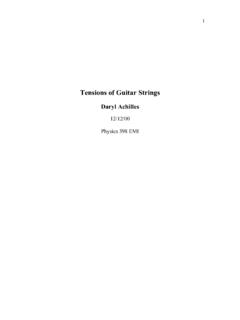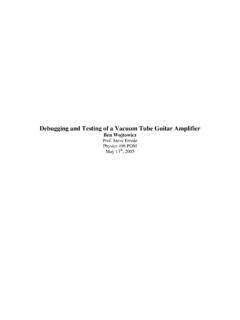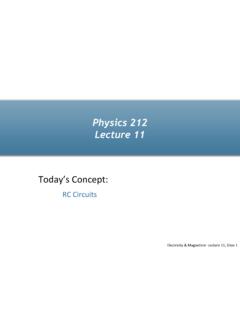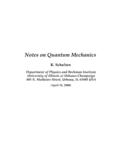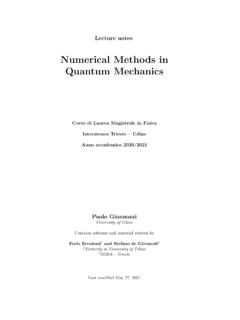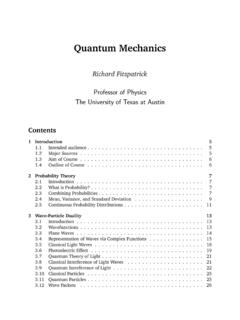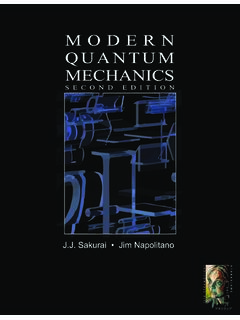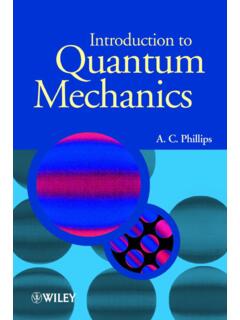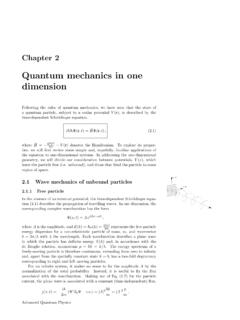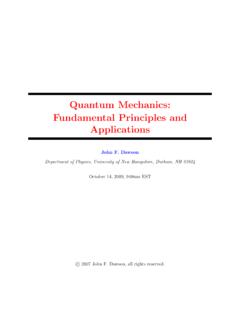Transcription of 1 Complex Numbers in Quantum Mechanics
1 1 Complex Numbers in Quantum MechanicsComplex Numbers and variables can be useful in classical physics. However, theyare not essential. To emphasize this, recall that forces, positions, momenta, potentials,electric and magnetic fields are all real quantities, and the equations describing them,Newton s laws, Maxwell s equations,etc. are all differential equations involving strictlyreal Mechanics is different. Factors ofi= 1 are everywhere, for examplefrom Heisenberg we have his famous commutation relation,QP P Q=i h,and from Schr odinger his equally famous equation hi t =H .The wave function is Complex and so is practically every other quantity neededto formulate Quantum Mechanics . Granted that classical Mechanics fails at distancesof nanometer or less, why is it suddenly so necessary that everything be Complex ?Comment 1An interesting question is the distance scale below whicha Quantum treatment is essential. A nanometer seems like a reasonablechoice.
2 But even more intriguing is the question of what happens onmuch bigger scales, centimeters, meters, and larger. Does quantummechanics still govern things, or does it somehow break down? In2011, it is fair to say no definite answer to this question is to the question of why Quantum Mechanics requires Complex quantities,one reason becomes apparent upon trying to describe wavelike phenomena for materialparticles, electrons, neutrons, etc. To see this point, start with a classical electromagneticwave. For a plane wave traveling along thez axis, we can write the following formulafor the electric field, E=E0 xcos(kz t).(1)To be more realistic, we should of course superpose nearby frequencies so that the wavehas a finite extent. However, the observation we will make applies equally well whether wehave a single frequency or a superposition of a narrow range of frequencies. For simplicity,we will use the simple formula Eq.(1). We may break Eq.(1) into pure exponentials ,so-called positive frequency and negative frequency parts; E=E0 x(e i!)
3 T+ikx+ei!t ikx).(By long-established convention exp( i t) is taken to be the positive frequency part( >0 here), and exp(+i t) is the negative frequency part.) The important point is that1in classical physics, since everything is ultimately real, positive and negative frequencyparts have to be present in equal turn to material (or massive) particles. They show wave phenomena (interfer-ence, diffraction, etc) with wavelengths determined by De Broglie, =hpork=p phenomena were first demonstrated for electrons by Davisson and Germer(Phys Rev30, 705 (1927)), working at the Bell Telephone Lab in NY, Davisson-Germer experiment and many other subsequent experiments establishthat massive particles with definite momenta have wave-like properties. Given that, onewishes to write down a formula describing traveling waves for massive particles. A firstthought would be a formula analogous to Eq.(1). But this cannot work for the followingreason. A single material particle traveling along certainly has apositive energy.
4 Thisis true whether we use the full Einstein formulaE= (pc)2+ (m0c2)2or the non-relativistic kinetic energy,Enr=p2/2m. Furthermore, energy and frequency are relatedby the Einstein-Planck formulaE= h ,(2)so givenE >0,we must have >0. ( The photoelectric effect establishes the Einstein-Planck formula without a doubt.) The conclusion is that a wave-function for a singlematerial particle must have only apositive frequency part. So ,whatever it repre-sents, must vary as follows e i!t+ fact that exp(ikz) goes with exp( i t) is saying the particle is traveling along the+z-axis. If it were traveling in the negative z-direction, we would have exp( ikz), butregardless of the direction of travel, the time-dependence must be of the form exp( i t)with =E/ hpositive. So to allow for wavelike phenomena and at the same time allowonly positive frequencies as required by positive energy for a free particles, complexfunctions must enter Quantum and harmonic oscillatorsThe agrement just given leads to the introductionof a still-mysterious Complex wave-function for massive particles.
5 But the Einstein-Planck formula Eq.(2) was first written down for photons, and surely applies to them aswell. A classical electromagnetic wave whose electric field could be given by Eq.(1) isquantum-mechanically a collection of many photons. Each of them has positive energy,given by Eq.(2), yet the formula for the electric field contains both positive and negativefrequencies. This needs some explanation. The first thing to note (and recall fromundergrad QM) is that any classical quantity such as a position, a momentum, or anelectromagnetic field component, is represented in Quantum Mechanics as an expectedvalue of an operator. This applies to the electric field of our plane wave. It is composedof photons with energies given by the Einstein-Planck formula Eq.(2), and will show2classical behavior if many photons are present. The numerical value of the electric fieldwill be the expected value of an electric field operator. You will learn how to handle thisoperator later in the course, but in the end, the electromagnetic field is nothing but abunch of harmonic oscillators.
6 So we can study the point about positive and negativefrequencies by examining a simple harmonic oscillator. Classically, we can writex(t) =Ae i!t+ Aei!t.(3)In Quantum Mechanics ,x(t) will be the expected value of the position operatorx, writtenas< x(t)>. ( We are abusing notation by using the same symbol for the classical positionand the Quantum operator. This is common practice in physics.) Since the expected valueis real, certainly both positive and negative frequencies appear, just as in Eq.(3).SummaryThe really important points of the above discussion are: (1) Einstein andPlanck have taught us that energy and frequency are proportional, the proportionalityconstant being Planck s constant. (2) Energy is not like momentum where positive andnegative values both occur equally. The energy of any system has a lower bound andallowed energies go up from there. So it is natural when we write a quantity that variesas exp( i t), that we will not always have a balancing term the varies as exp(i t),although this will happen when we are examining an expected value of an operator.
7 Sincecomplex conjugates are bound to occur, there will also be cases where terms exp(+i t)do not have a balancing exp( i t).Bottom line:In Quantum Mechanics , complexnumbers are Photon Polarization, Probability and Interferencein Quantum MechanicsThe existence of polarized light gives a wonderful example where both classical ideas andone of the most puzzling features of Quantum Mechanics coexist. Polarization is veryfamiliar in daily life. Almost everyone who wears sunglasses wears polarized sunglasses,which are designed to absorb horizontally polarized light. This can be experienced at thelocal gas station when you fill your gas tank. If you are wearing polarized sunglasses, youwill quickly discover that the light emitted by the display on the gas pump is those who do not operate cars, try putting on your polarized sunglasses the nexttime you are in front of a computer monitor. Tilting your head reveals that the lightfrom the monitor is highly us start by discussing a classical beam of monochromatic light, traveling alongthe +zaxis.
8 Imagine we have ideal polarizer placed in this beam with its axis along the+yaxis. This means that light polarized along yis (ideally) 100% transmitted, whilelight polarized along the xaxis is totally absorbed. Now if the incident light is polarizedat say an angle with respect to theyaxis, we simply resolve the polarization into a3component along theyaxis, and one along thexaxis. Only the component along theyaxis gets transmitted, and the transmitted intensity satisfies the classical Malus Law:I( ) =I(0) cos2 ,(4)whereI( ) is theintensityof transmitted light, when the incident light is polarized atangle to the axis of the polarizer. This is all well-known seemingly pure classical Malus law puts no restriction on the intensity of the incident light. So imaginethat we gradually but steadily reduce the intensity to the point where we are consideringthe process photon by photon. At this point Quantum physics enters the picture, but onlyin a very general way.
9 We visualize a classical light beam as composed of photons, eachsatisfying the Einstein-Planck formula relating frequency and energy. For this discussion,we don t need this formula. All we do need is the assertion that photons cannot be brokeninto pieces, only whole photons are observed beyond the polarizer. Now as long as thephoton s polarization vector is either along y,or along x,there is still no need for newideas. The photon polarized along ygets transmitted, the one polarized along xgetsabsorbed. New ideas do enter when we have a photon incident whose polarization vectoris at angle with respect to polarization vector for an individual photon is aunitvector, which we could write for our present discussion as P= cos y+ sin x.(5)This is the polarization vector of the photon which is incident on the polarizer. Beyondthe polarizer, there either a photon or no photon. If there is a photon, its polarizationvector is this experiment is repeated over and over, always with the samepolarization for the incident photon, the frequency of observation of photons transmittedbeyond the polarizer is cos2.
10 Whether a given photon is transmitted is apparentlyrandom. Large Numbers of observations are needed to observe the cos2 law. Thisis indeed something new and unfamiliar at the macroscopic level. To interpret thisresult requires the introduction of probability into Quantum Mechanics . In our example,probability is invoked as follows. We know that if the photon polarization is along y,thephoton is transmitted, while if its polarization is along x,it is absorbed. We say that theprobability amplitudeof our photon being found with its polarization along yis y P= cos ,(6)and theprobabilityof the photon being found with polarization along yis the absolutesquare of the probability amplitude. Denoting this probability aspy,we can writepy=| y P|2(7)Note that we did not need the absolute value in Eq.(7). However, probability amplitudesare Complex in general, so to get a real probability, it is necessary to take the absolutesquare of the probability amplitude.
